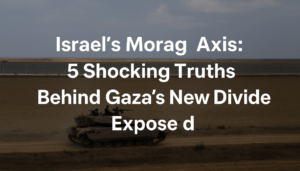Israel’s Morag Axis: 5 Shocking Truths Behind Gaza’s New Divide Exposed
Israeli Prime Minister Benjamin Netanyahu recently announced the capture of what he calls the “Morag axis” — a strategic strip of land in southern Gaza between Khan Younis and Rafah. This corridor cuts through an area that Israel previously labeled a “humanitarian zone,” where many displaced Palestinians had sought refuge. The move is part of a broader effort to divide Gaza, isolating Rafah and increasing pressure on Hamas to release hostages.
However, Israeli military sources admitted the plan had not been formally approved, raising concerns about troop safety. Heavy bombardment and ground assaults in Rafah have already claimed over 1,000 Palestinian lives in recent weeks, with total deaths in Gaza now exceeding 50,000 since October 2023. Observers say the strategy mirrors earlier tactics, like the Netzarim and Philadelphi corridors, aimed at fragmenting Gaza’s population. Some Israeli media link the operation to former U.S. President Donald Trump’s proposal to remove Palestinians from the territory.
Netanyahu has labeled the “Morag axis” as a “Second Philadelphi,” suggesting long-term plans to reshape Gaza’s geography and demographics.

Israel’s Morag Axis: 5 Shocking Truths Behind Gaza’s New Divide Exposed
Israeli Prime Minister Benjamin Netanyahu recently declared that Israeli forces had seized control of a strategic area in southern Gaza called the “Morag axis.” Located between the cities of Khan Younis and Rafah, this east-west corridor cuts through land that Israel had earlier designated as a “humanitarian zone” for displaced Palestinians. The name “Morag” traces back to an Israeli settlement dismantled in 2005. Until now, the term hadn’t been used to describe a military zone or pathway.
What’s the Goal of the Morag Axis?
Netanyahu claims the takeover aims to isolate Rafah from Khan Younis, effectively splitting southern Gaza. He argues this will pressure Hamas to release Israeli hostages. However, the move has sparked criticism even within Israel’s defense establishment. Some officials revealed the plan lacked formal military approval and could endanger troops on the ground.
This strategy mirrors Israel’s earlier efforts to fragment Gaza. In northern Gaza, the “Netzarim Corridor” blocked movement between Gaza City and central regions. Similarly, the “Philadelphi Corridor” along Gaza’s border with Egypt restricts access to the outside world. By controlling these routes, Israel has severely limited the ability of Palestinians to flee conflict zones or access essential supplies.
Rafah Under Siege
Since Israel resumed military operations in Rafah last month, over 1,000 Palestinians have been killed. The city, once a crowded refuge for displaced families, now faces relentless airstrikes and ground attacks, including reported assaults on homes and medical teams. The total death toll in Gaza since October 2023 has surpassed 50,400.
Rafah’s significance lies in its role as a last-resort shelter for civilians fleeing violence elsewhere. Now, Israeli forces aim to fully encircle the city, raising fears of further devastation. Thousands remain trapped with dwindling access to food, water, and healthcare.
The Broader Strategy
Reports from Israel’s Channel 12 suggest the separation of Khan Younis and Rafah aligns with a larger, controversial vision—one allegedly inspired by a U.S. proposal under former President Donald Trump. While details remain vague, the plan reportedly included relocating Palestinians out of Gaza entirely. Though Netanyahu hasn’t explicitly endorsed mass displacement, his rhetoric and actions hint at long-term territorial control.
The prime minister has likened the Morag route to the “Second Philadelphi,” referencing the buffer zone along Gaza’s Egyptian border. This comparison implies Israel may seek to establish another permanent military-controlled area inside Gaza. Such a move could further destabilize the region, undermining prospects for Palestinian self-governance.
Internal Conflicts and Global Concerns
Despite Netanyahu’s public confidence, Israeli defense officials admit parts of the Morag plan lack clarity. Openly discussing the seizure of the corridor, some argue, risks exposing troop positions and complicating operations. Meanwhile, international calls for a ceasefire have gone unheeded. Israel continues to hold strategic corridors, suggesting a prolonged campaign to divide Gaza into isolated pockets.
Critics warn these actions could amount to collective punishment, exacerbating Gaza’s humanitarian crisis. By fragmenting the territory, Israel tightens its grip over Palestinian movement, resources, and access to aid. For displaced families already living in makeshift tents, the loss of “humanitarian zones” deepens their vulnerability.
Looking Ahead
The Morag Axis underscores Israel’s shifting tactics in Gaza. While framed as a bid to pressure Hamas, its broader implications—military, humanitarian, and political—are stark. The division of Gaza risks entrenching Israel’s occupation, complicating future peace efforts. For Palestinians, already reeling from months of bombardment, the strategy signals more hardship and uncertainty.
As global attention wavers, the urgency for a sustainable resolution grows. Without meaningful dialogue or international intervention, Gaza’s fragmentation could become irreversible, leaving its population trapped in an unending cycle of displacement and despair.
You must be logged in to post a comment.